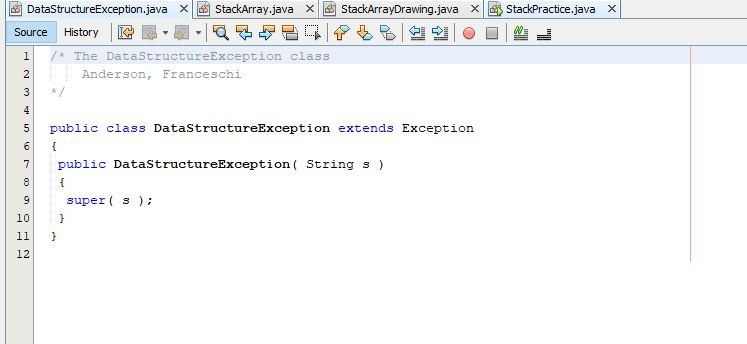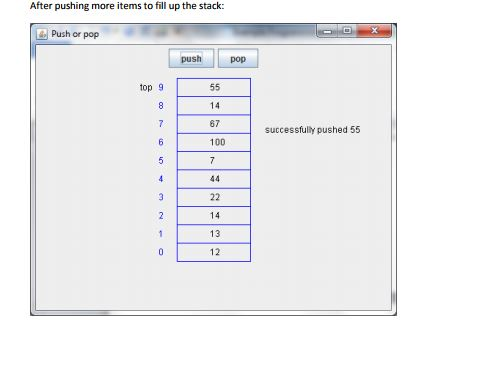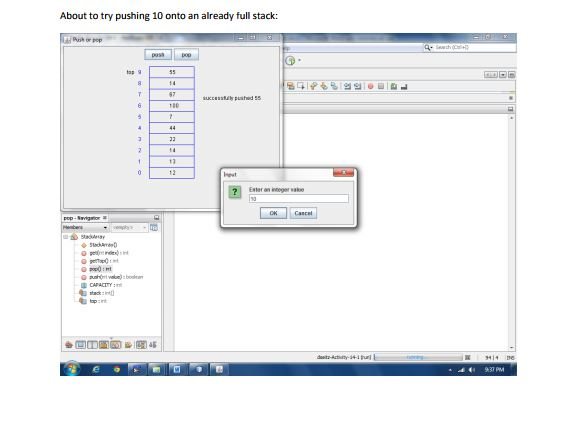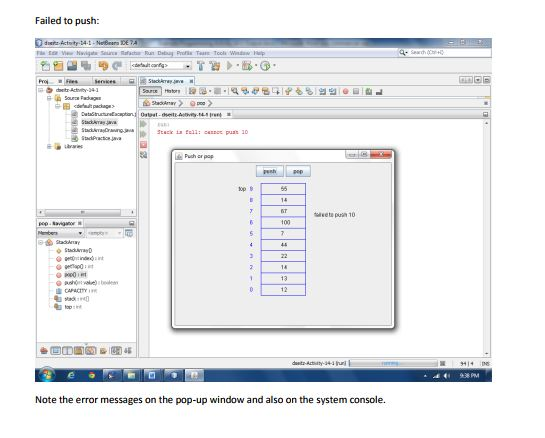Question
/* StackArrayDrawing * Anderson, Franceschi */ import java.awt.Graphics; import javax.swing.JFrame; import java.awt.Color; public class StackArrayDrawing { public static final int XSTART = 200; public static

/* StackArrayDrawing * Anderson, Franceschi */
import java.awt.Graphics; import javax.swing.JFrame; import java.awt.Color;
public class StackArrayDrawing { public static final int XSTART = 200; public static final int YSTART = 300; public static final int WIDTH = 100; public static final int HEIGHT = 25;
private StackArray sa;
private boolean pushSuccess; private boolean popSuccess; private int pushedValue; private int poppedValue;
private boolean operation; // true for push, false for pop private String description = ""; private boolean started;
public StackArrayDrawing( ) { sa = new StackArray( ); }
public void setPushSuccess( boolean newPushSuccess ) { started = true; pushSuccess = newPushSuccess; }
public void setPopSuccess( boolean newPopSuccess ) { popSuccess = newPopSuccess; }
public void setPushedValue( int newPushedValue ) { pushedValue = newPushedValue; }
public void setPoppedValue( int newPoppedValue ) { poppedValue = newPoppedValue; }
public void setOperation( boolean newOperation ) { operation = newOperation; }
public void setStarted( boolean newStarted ) { started = newStarted; }
public boolean push( int value ) { return ( sa.push( value ) ); }
public int pop( ) throws DataStructureException { return( sa.pop( ) ); }
public void draw( Graphics g ) { // draw the empty stack and indices g.setColor( Color.BLUE ); drawEmptyStack( g );
// draw the stack contents g.setColor( Color.RED ); drawStackContents( g );
// draw top g.setColor( Color.BLACK ); drawTop( g );
// determine operation if ( operation ) // push { if ( pushSuccess ) { description = "successfully pushed " + pushedValue; } else { description = "failed to push " + pushedValue; } } else // pop { if ( popSuccess ) { description = "successfully popped " + poppedValue; } else { description = "failed to pop"; } } if ( !started ) description = ""; drawDescription( g ); }
public void drawEmptyStack( Graphics g ) { for ( int i = 0; i
public void drawStackContents( Graphics g ) { int i = 0; g.setColor( Color.BLACK ); for ( i = 0; i
public void drawTop( Graphics g ) { g.drawString( "top", XSTART - WIDTH / 2, (int) ( YSTART - ( sa.getTop( ) - 0.7 ) * HEIGHT ) ); }
public void drawDescription( Graphics g ) { g.drawString( description, XSTART + WIDTH + 20, YSTART / 2 ); } }
//////////////////////////////////////////////////////////////////////////////////////////////////////////////////////////////////////////////////////////////////////////////////////////////////////
/* StackArray * Anderson, Franceschi */
import java.awt.Graphics; import javax.swing.JFrame; import java.awt.Color;
public class StackArray { public static final int CAPACITY = 10;
private int[] stack; private int top;
public StackArray() { stack = new int[CAPACITY]; top = -1; }
public int get(int index) { return stack[index]; }
public int getTop() { return top; }
/** * push method * * @param value value to be pushed onto the stack * @return true if successful, false if unsuccessful */ public boolean push(int value) { // ***** 1. Student code starts here ***** // stack is an int array instance variable representing // the array that stores our stack
// top is an instance variable representing // the index of the top of the stack // CAPACITY is a constant instance variable representing // the size of the array stack // The push method adds the argument value // to the top of the stack, if it is possible // code the push method here // Part 1 student code starts here:
return true; // replace this dummy return statement
// Part 1 student code ends here. }
/** * pop method * * @return the value of the top element of the stack, if successful */ public int pop() throws DataStructureException { // ***** 2. Student code restarts here ***** // stack is an int array instance variable representing // the array that stores our stack
// top is an instance variable representing // the index of the top of the stack // CAPACITY is a constant instance variable representing // the size of the array stack // The pop method deletes the element // at the top of the stack, if it is possible // Code the pop method here // Part 2 student code starts here:
return 0; // replace this dummy return statement
// Part 2 student code ends here. } }
output



Step by Step Solution
There are 3 Steps involved in it
Step: 1

Get Instant Access to Expert-Tailored Solutions
See step-by-step solutions with expert insights and AI powered tools for academic success
Step: 2

Step: 3

Ace Your Homework with AI
Get the answers you need in no time with our AI-driven, step-by-step assistance
Get Started


